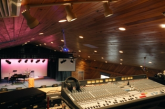Tips to Maximize Sound System Performance
We often receive calls from companies that have had their sound system installed by someone else telling us that the quality of the sound is not as good as it could be or as they expected. Sometimes we find that the installations were done by someone's 'friend' or that the equipment was purchased from a big box retailer and more suited for a home environment and not a corporate or church environment.
If you are finding that your sound quality is not crystal clear here are some things to consider/look for:
If you are finding that your sound quality is not crystal clear here are some things to consider/look for:
- Locate Speakers Properly
Proper speaker placement is critical to get the best sound from your speakers. Consider your room - where does the audience sit? Are there blocks (poles, screens, etc) between the audience and the speaker location? Is each speaker equal distance from your audience? Try not to place speakers in a corner. Are all speakers 'aimed' to maximize their performance? - Reduce Interference
Low impedance, balanced microphones and systems are more resistant to interference from outside sources such as RF signals (radio frequency) and electro-magnetic frequencies. By using cables and equipment that is shielded you can reduce the 'bleed' of other sounds through your system. Sometimes reducing the length of a cable can also help reduce the interference from outside sources. - Evaluate and Adjust All Wireless Components
Related to interference, evaluating and adjusting any/all wireless components ensures reliable performance. These devices are routinely exposed to the world around them from an RF standpoint. While this doesn't hurt them in any way, they are always having to decide what is 'good' to decode and send to the audio system. Most units are frequency agile meaning that the communication channel can be changed if a channel is not working well. - Check The Grounding of Equipment/Evaluate all Wiring
Chances are your system has a three-pronged grounded plug. Be sure that it is plugged into an electrical outlet that is properly wired and grounded. Ideally the outlets that service your sound equipment should have their own dedicated ground. While some systems are relatively simple, any system can be sunk with a problematic cable or connector. All interfacing components must not only be electronically evaluated but mechanically evaluated as well. - Manage Equalization and Amplification
The goal of equalization is to make the sound that someone hears from a speaker as close to the sound that went into the microphone. Equalization is best done with a combination of listening - how does the sound sound? And through detailed calculations that take into account a number of items (best done by a sound technician).
Amplification relates to volume. Some speakers will not respond well to high-volumes. We find that many times when companies are experiencing poor sound it is because they had to turn the volume up so everyone can hear but the speaker no longer has clear sound at that high volume level. Try turning the volume down and checking the quality of the sound. If the sound quality is still poor at the lower volume then you know you have another problem. All tests of this type are done at the 'head-end of the system where the electronic components reside. Sometimes we are able to resolve issues in the speaker by making simple adjustments like cleaning an air filter. - Adjust the Signal Chain
Signal chain adjustments maximize signal to noise while adjusting for any potential cause of distortion. The primary control is the system mixer which has the daunting task of receiving signals at varying levels and applying amplification of possibly 1000x just to get individual inputs to a balanced level. Most system mixers are up to the challenge, but a misguided adjustment can be worse than politicians controlling healthcare.
These suggestions will help you look at the basics of sound system functioning. Obviously, there are times when you need to call a trained technician. When that happens, think of Shanahan Sound and Electronic. We can test, adjust and repair/replace your equipment so you receive the best sound and video output possible.
Let us help you turn your audio and visual requirements into reality. Give us a call at 800-786-1556 or email us today. One of our professionals will be happy to work with you.



